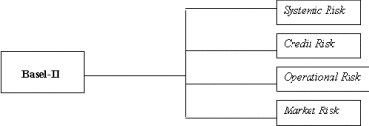|
Part - I
Introduction: Need for Basel II
The Basel I & II recommendations of the Bank of International Settlements (BIS) have been framed with the objective of ensuring adequate capitalization of banks assets and lessen the credit and operational risks faced by the banks.
The principal solecism in the Basel I proposal was that it dealt with credit risk only. Other types of risks faced by a bank like interest rate risk, foreign exchange risk and operational risks were not dealt with at all. Hence there was an inadequate estimation of the overall risks faced by a bank under Basel I. This could result in under-capitalization of the banking sector as a whole and could give rise to systemic risk and bank crises in the long run. One cannot possibly imagine the effects on the world financial system due to the collapse of banks like Citigroup or J.P. Morgan Chase. Basel II tries to address exactly this (systemic risk) and other forms of risks like credit risk, operational risk and market-risk.

Exhibit 1: Risks handled by Basel-II Norms
The Basel II recommendations are based on three pillars; Minimum Capital requirement: supervisory review: Market Discipline. The design is to evaluate the risks scientifically and provide incentives to banks to evolve and adopt more sophisticated techniques by means of autonomous risk assessment. In long term these recommendations by means of various measures would be able to influence Corporate Governance and better risk management through self assessed needs. The issues of Basel II are multiple and can vary from country to country depending on the banking environment of each state.
Next
* Contributed by -
Harshdeep Jolly & Anurag Ghuwalewala,
PGP 2,
IIM Bangalore.
|